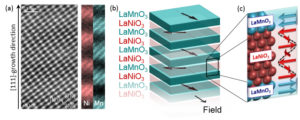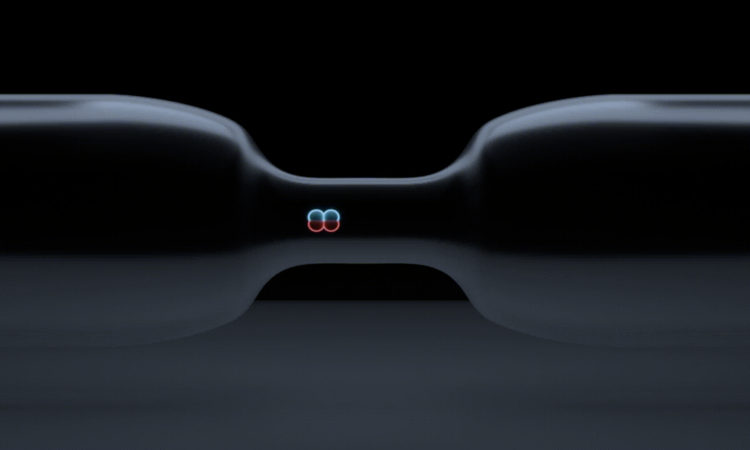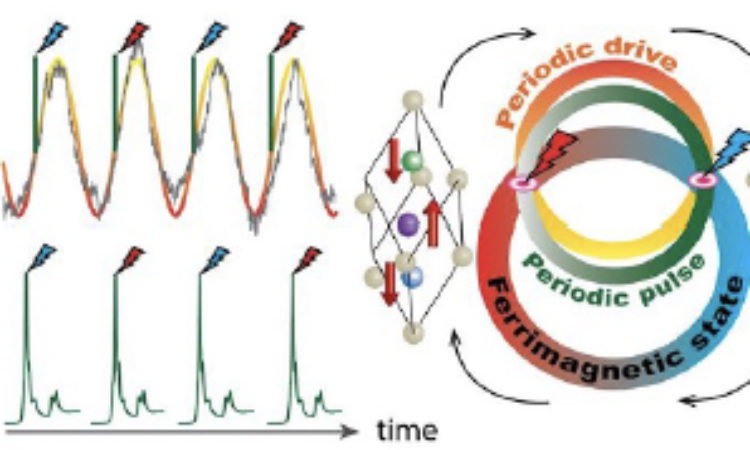Generation of « tailored » magnetic materials
Interlayer coupling through a dimensionality-induced magnetic state
By Marta Gibert and Jean-Marc Triscone, Department of Quantum Matter Physics, UNIGE
Contact: Prof. Jean-Marc Triscone (Tél. +41 22 379 62 18)
Based on article published in Nature Communication
Press release French/English
Every day, new technologies require more precision in the intrinsic properties of the materials used. To meet increasingly specific requirements, physicists are interested in a generation of artificial materials, the properties of which can be controlled. Researchers at the University of Geneva (UNIGE), Switzerland, in collaboration with French and English teams, have succeed in manipulating the properties of two oxides which make up the artificial material, more exactly they managed to modify the magnetic properties which can be either ferromagnetic or antiferromagnetic; that is, with or without net magnetic moment. The scientists have demonstrated, in their study published in Nature Communications, that they are able now to control the magnetism in this type of materials and that they could, in the near future, offer tailored materials for the devices of tomorrow.
Over the past decade, atomic-scale control of heterointerfaces between different perovskite oxides has grown to become a well-established route to engineering new functionalities in transition metal oxides.1, 2 These artificial structures not only allow the functionalities of the individual compounds to be combined in the same system, but very often lead to the emergence of new physical properties different from those of the building blocks.
In a recent work published in Nat. Commun.,3 Marta Gibert et al. from UNIGE, together with French and English teams, demonstrate how reduced dimensionality together with interface engineering can be used not only to induce a new magnetic phase in an otherwise non-magnetic material but also, under carefully orchestrated circumstances, to generate rich and complex magnetic behaviour in a seemingly simple, two-component oxide heterostructure. This is found in LaNiO3-LaMnO3 superlattices grown along the less-conventional [111]-direction on SrTiO3 substrates. Although LaNiO3 is the only bulk nickelate that is metallic and non-magnetic at all temperatures, it is found to become insulating in thin film form as the thickness is reduced to just a few unit cells.4 LaMnO3 is an insulating antiferromagnet in the bulk. Thin films of LaMnO3, however, are still insulating but display ferromagnetic order when grown on cubic SrTiO3 substrates. At LaNiO3/LaMnO3 interfaces, charge transfer from Mn to Ni occurs leading to a ferromagnetic interaction between the cations.5
Previously, the Geneva group had reported on the unexpected observation of an exchange bias behavior at low temperature in these (111)-oriented LaNiO3-LaMnO3 superlattices, which was explained through the emergence of magnetism in the LaNiO3 layers.6 Now, detailed studies combining SQUID-magnetometry and x-ray resonant reflectivity measurements have revealed a complex magnetic evolution in this system as a function of temperature. It has been seen that for the specific case of superlattices containing 7-monolayer-thick-[111]-LaNiO3 layers, the exchange bias first reverses sign from negative to positive as the temperature is increased – a unique behavior – before to vanish around 30 K. Above 30K, an antiferromagnetic-coupled state between the LaMnO3 layers is observed (as schematically shown in Figure 1b). This rich behavior is explained through the emergence of a (¼,¼,¼)- antiferromagnetic order in the ultrathin insulating (111) LaNiO3 layers, akin to that of the other perovskite nickelates.7
As schematized in Figure 1c, such a magnetic state exclusively propagates antiferromagnetic exchange coupling through the precisely 7 unit cells of LaNiO3. The induced spiral antiferromagnetic spin structure is stabilized by direct contact along the [111] planes that enhances magnetic interactions with the ferromagnetic insulating manganite and concomitant with the appearance of an insulating behaviour. The choice of growth orientation and the digital design of the heterostructure periodicity – this behavior being only observed for 7-monolayers-[111]-LaNiO3 – are key in maximizing the interfacial interactions. The interfacial ferromagnetic coupling between Ni and Mn 5 and an intrinsic structural asymmetry of the interfaces8 are the other essential elements necessary to explain the complex magnetic evolution observed.

This work, however, goes beyond the mere evidence for the existence of a dimensionality-induced magnetic structure as it demonstrates that such structures can be used to propagate a coupling interaction of chosen sign between neighboring ferromagnetic LaMnO3 layers. It is a proof-of-principle demonstration that technologically important effects, such as exchange coupling, can be tailored using complex antiferromagnetic arrangements with unit cell control. Such control of the magnetic interactions could especially be of interest for future magnetic memories. Interestingly, this research based on engineering of materials by design is not limited to magnetic materials, but is also of interest, for example, for multiferroics or even to eventually design synthetic superconducting materials ideally working at higher temperatures.
References
- P. Zubko, S. Gariglio, M. Gabay, P. Ghosez, J.-M. Triscone,”Interface Physics in Complex Oxide Heterostructures”, Annu. Rev. Condens. Matter Phys. 2, 141-165 (2011).
- H. Y. Hwang, Y. Iwasa, M. Kawasaki, B. Keimer, N. Nagaosa, Y. Tokura,”Emergent phenomena at oxide interfaces”, Nat. Mater. 11, 103-113 (2012).
- M. Gibert, M. Viret, P. Zubko, N. Jaouen, J.-M. Tonnerre, A. Torres-Pardo, S. Catalano, A. Gloter, O. Stéphan, J. M. Triscone,”Interlayer coupling through a dimensionality-induced magnetic state in LaNiO3“, Nat. Commun.
- R. Scherwitzl, P. Zubko, C. Lichtensteiger, J. M. Triscone,”Electric-field tuning of the metal-insulator transition in ultrathin films of LaNiO3“, Appl. Phys. Lett. 95, 222114 (2009).
- C. Piamonteze, M. Gibert, J. Heidler, J. Dreiser, S. Rusponi, H. Brune, J. M. Triscone, F. Nolting, U. Staub,”Interfacial properties of LaMnO3/LaNiO3 superlattices grown along (001) and (111) orientations”, Phys. Rev. B 92, 014426 (2015).
- M. Gibert, P. Zubko, R. Scherwitzl, J. Íñiguez, J.-M. Triscone,”Exchange bias in LaNiO3–LaMnO3 superlattices”, Nat. Mater. 11, 195-198 (2012).
- J. L. Garcia-Muñoz, J. Rodriguez-Carvajal, P. Lacorre,”Neutron-diffraction study of the magnetic ordering in the insulating regime of the perovskites RNiO3 (R=Pr and Nd)”, Phys. Rev. B 50, 978-992 (1994).
- M. Gibert, M. Viret, A. Torres-Pardo, C. Piamonteze, P. Zubko, N. Jaouen, J. M. Tonnerre, A. Mougin, J. Fowlie, S. Catalano, A. Gloter, O. Stéphan, J. M. Triscone,”Interfacial Control of Magnetic Properties at LaMnO3/LaNiO3 Interfaces”, Nano Letters 15, 7355-7361 (2015).



